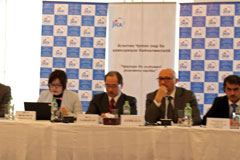Survey Results on Migration and Remittances in Tajikistan Shared at Seminar
2019.04.12
Tajikistan is one of the most remittance-dependent countries in the world. The remittance inflow in Tajikistan reached its peak in 2013, amounting to $US3.7 billion and making up 42 percent of GDP. Since 2005, Tajikistan has been ranked as one of the top countries in terms of remittances’ share of GDP, which has been as high as 50 percent. While the remittance inflow to Tajikistan has slowed to some extent because of the Russian economic downturn in 2014-2015 and consequent tighter immigration rules, it started to pick up again in 2017.

JICA-RI Research Fellow Enerelt Murakami (far left) shared some preliminary findings from a survey
To study the complex problems associated with migration and remittances in Tajikistan, JICA-RI conducted a nationally representative household survey in 2018. This is a follow-up survey to the Tajikistan Jobs, Skills, and Migration Survey, conducted by the World Bank and the German Federal Enterprise for International Cooperation (GIZ) as part of the Central Asia Longitudinal Inclusive Society Survey (CALISS) in 2013. The dissemination seminar on the key preliminary results of the survey was hosted by JICA in Dushanbe, Tajikistan, on Feb. 20, 2019. JICA-RI Research Fellow Enerelt Murakami and Visiting Scholar Akira Murata visited Dushanbe to participate in the seminar, and presented preliminary results on the main findings from the survey. About 60 delegates from government and international organizations participated in the event.
The seminar was opened by JICA Tajikistan Office Chief Representative Hideki Tanabe, who emphasized the importance of the survey and how the results can be put to use for better operation of JICA’s activities in Tajikistan.
Then, Murakami gave a brief summary of the survey results. As preliminary findings, she explained the share of migrant households by region, the number of international migrants per household and other migration-related statistics from the survey. She compared the 2013 and 2018 survey results, saying the migration trend had not changed much. She indicated that Russia is the major destination country that accounts for over 90 percent of Tajik migrants. The majority of the survey respondents said their primary purpose in migrating was to work and remit money back home.
In the Q&A session that followed, most questions and comments centered around issues of education since most Tajik labor migrants are engaged in low skilled jobs in Russia that pay much higher wages than even high-skilled jobs in Tajikistan, depriving Tajik youth of an incentive to pursue higher education. There was an active discussion, in which an audience member raised the issue that education quality is low and even higher education does not provide enough skills to be employable in Tajikistan.

事業事前評価表(地球規模課題対応国際科学技術協力(SATREPS)).国際協力機構 地球環境部 . 防災第一チーム. 1.案件名.国 名: フィリピン共和国.

事業事前評価表(地球規模課題対応国際科学技術協力(SATREPS)).国際協力機構 地球環境部 . 防災第一チーム. 1.案件名.国 名: フィリピン共和国.

事業事前評価表(地球規模課題対応国際科学技術協力(SATREPS)).国際協力機構 地球環境部 . 防災第一チーム. 1.案件名.国 名: フィリピン共和国.

事業事前評価表(地球規模課題対応国際科学技術協力(SATREPS)).国際協力機構 地球環境部 . 防災第一チーム. 1.案件名.国 名: フィリピン共和国.

事業事前評価表(地球規模課題対応国際科学技術協力(SATREPS)).国際協力機構 地球環境部 . 防災第一チーム. 1.案件名.国 名: フィリピン共和国.
scroll